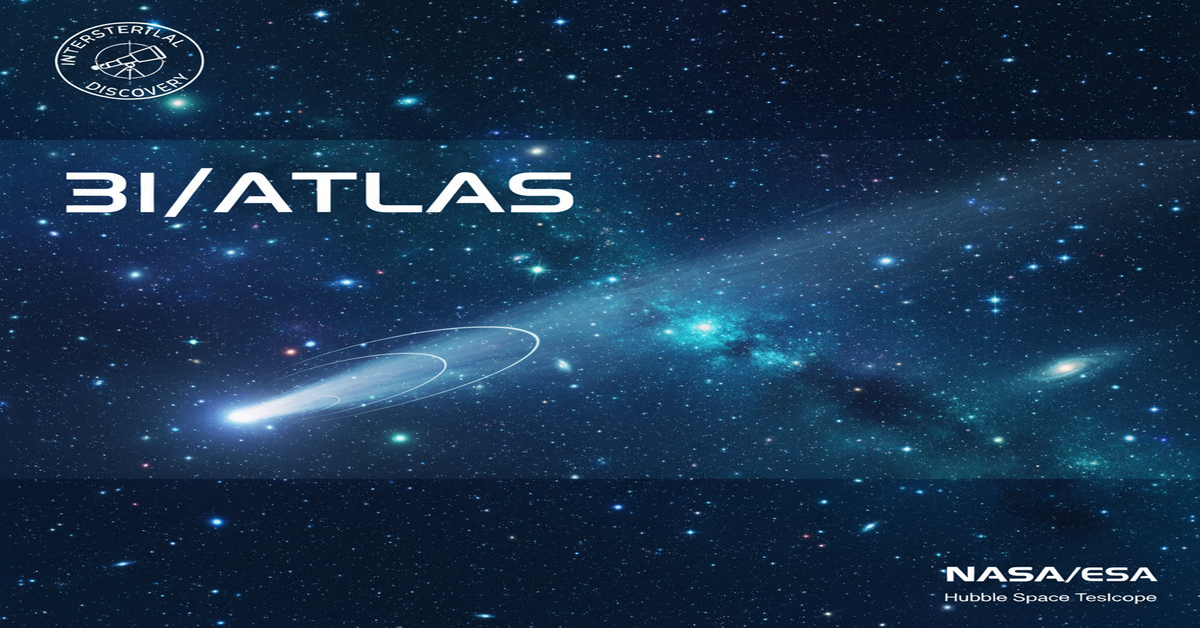154/2
Interstellar Comet 3I/Atlas: Scientists Discover Rare Celestial Visitor
Interstellar Comet 3I/Atlas: Scientific Breakthrough, Safety Assessment, and the Alien Technology Debate
Meta Description: Comprehensive analysis of interstellar comet 3I/Atlas: scientific discoveries, safety assessment, Harvard alien technology theories, and viewing information. Expert insights on this historic celestial visitor.
Keywords: interstellar comet, 3I/Atlas, alien technology, Harvard Avi Loeb, NASA, JWST, space science, astronomy
Safety First: NASA confirms that Comet 3I/Atlas poses no threat to Earth. The closest approach on December 19, 2025, will be approximately 270 million kilometers away—far beyond the Moon’s orbit.
Introduction: A Visitor from Beyond Our Solar System
In the vast expanse of space, visitors occasionally make their way into our cosmic neighborhood from distant star systems. Such is the case with Comet 3I/Atlas, the third confirmed interstellar object to grace our Solar System—a cosmic wanderer that has captured the attention of astronomers, scientists, and the public worldwide.
This extraordinary celestial object, discovered on July 1, 2025, by the NASA-funded ATLAS survey in Chile, represents more than just another astronomical discovery. It’s a time capsule from another planetary system, offering unprecedented insights into the building blocks of worlds far beyond our Sun’s influence. What makes 3I/Atlas particularly fascinating is not just its interstellar origin, but the startling scientific revelations emerging from space-based observations and the provocative theories about its possible artificial nature.
As we stand at the threshold of this historic celestial event—with perihelion occurring around October 29-30, 2025—humanity finds itself at a unique moment in astronomical history. We have the opportunity to study an object that has traveled for countless light-years to reach our cosmic doorstep, carrying with it the secrets of distant worlds.
154/2
The Discovery: Unveiling Our Third Interstellar Guest
Comet 3I/Atlas emerged from the depths of space with a story millions of years in the making. The ATLAS (Asteroid Terrestrial-impact Last Alert System) survey, designed primarily for planetary defense, accidentally captured images of this cosmic traveler on July 1, 2025. What initially appeared as another routine detection soon revealed itself as something far more extraordinary.
Precovery analysis—astronomical detective work that involves searching through archived observations—revealed that 3I/Atlas had actually been imaged weeks earlier, in mid-June 2025. This earlier appearance provided crucial data for calculating its trajectory and confirming what scientists had suspected: this was no ordinary comet.
The Hyperbolic Journey
What distinguishes 3I/Atlas as an interstellar object is its hyperbolic trajectory—a path that will carry it through our Solar System once, never to return. Unlike comets from the Oort Cloud or Kuiper Belt that orbit our Sun, 3I/Atlas is on a one-way journey back into the void between stars.
The object’s hyperbolic excess velocity (v∞) of approximately 58 km/s makes it significantly faster than the previous interstellar visitors. To put this in perspective:
- 1I/’Oumuamua (our first interstellar guest in 2017): ~26 km/s
- 2I/Borisov (2019): ~32 km/s
- 3I/Atlas (2025): ~58 km/s
This high velocity, combined with its low-inclination retrograde orbit of about 5 degrees from the ecliptic plane, creates a rapid transit through the inner Solar System that presents both challenges and opportunities for observation.
The Interstellar Timeline: Key Celestial Milestones
Understanding 3I/Atlas’s journey requires mapping its passage through our cosmic neighborhood. Here’s the critical timeline that scientists and observers are closely monitoring:
October 3, 2025: Mars Encounter
The comet passed within 0.19 AU of Mars (approximately 28 million kilometers), providing Mars-orbiting spacecraft with a unique observing opportunity. ESA’s ExoMars and Mars Express missions captured this historic flyby from the Red Planet’s perspective.
October 21, 2025: Solar Conjunction
3I/Atlas disappeared behind the Sun as seen from Earth—a phenomenon called solar conjunction that created a two-to-three week observing gap for ground-based telescopes. This natural concealment would prove scientifically valuable, as we’ll explore later.
October 29-30, 2025: Perihelion
The moment of closest approach to the Sun, occurring at approximately 1.35-1.4 AU—just inside Mars’s orbit. This is when 3I/Atlas should exhibit maximum activity as solar heating triggers intense outgassing.
November 3, 2025: Venus Flyby
A close approach to Venus at about 0.65 AU (97 million kilometers), offering another opportunity for space-based observation during the post-perihelion period.
December 19, 2025: Earth’s Safe Passage
The closest approach to Earth at 1.80 AU (270 million kilometers)—well beyond the Moon’s orbit and absolutely safe for our planet. This timing coincides with the comet’s re-emergence from solar glare for ground-based observers.
March 16, 2026: Jupiter Departure
A final planetary encounter with Jupiter at 0.36 AU (54 million kilometers) as 3I/Atlas begins its journey back to interstellar space.
Critical Safety Assessment: Despite these “close approaches,” every planetary encounter occurs at distances millions of kilometers away. There is absolutely no risk of impact with any planet, including Earth.
Scientific Revelations: A Comet Unlike Any Other
What makes 3I/Atlas truly remarkable isn’t just its interstellar origin—it’s the startling chemical composition revealed by space-based telescopes, particularly the James Webb Space Telescope (JWST).
The Carbon Dioxide Mystery
The most groundbreaking discovery is that 3I/Atlas possesses a carbon dioxide-dominated atmosphere—a finding that fundamentally challenges our understanding of cometary chemistry. The CO₂-to-water vapor ratio is among the highest measured in any comet, suggesting this object formed under vastly different conditions than Solar System comets.
For context, typical comets in our Solar System are dominated by water ice, which sublimates (transforms from solid to gas) as they approach the Sun. But 3I/Atlas tells a different story:
| Component | Production Rate | Significance |
|———–|—————-|————–|
| Carbon Dioxide (CO₂) | ~129 kg/s | Dominant volatile, extremely unusual |
| Water (H₂O) | ~6.6 kg/s | Subdominant relative to CO₂ |
| Carbon Monoxide (CO) | ~14.0 kg/s | Typical levels for comets |
| Carbonyl Sulfide (OCS) | ~0.43 kg/s | Detected |
| Cyanide (CN) | ~17.6 g/s | Ground-based detection |
| Neutral Nickel (Ni I) | ~4.6 g/s | Unusual metallic emission |
Implications for Planetary Formation
This unusual chemistry suggests 3I/Atlas formed in a completely different part of the galaxy, where carbon dioxide ice was more abundant than water ice. This could indicate:
1. Different stellar environments with varying ice formation temperatures
2. Varying distances from the host star during formation
3. Distinct chemical pathways in distant protoplanetary disks
The presence of neutral nickel (Ni I) without corresponding iron (Fe I) emission adds another layer of mystery to the comet’s composition, suggesting unusual refractory metal release mechanisms not commonly observed in Solar System comets.
Physical Characteristics: Size, Shape, and Activity
Nucleus Constraints
The Hubble Space Telescope has provided crucial insights into 3I/Atlas’s physical dimensions, though the nucleus itself remains unresolved due to the surrounding dust cocoon. Current estimates constrain the nucleus diameter to between 320 meters and 5.6 kilometers—a wide range that reflects the uncertainty in our measurements.
The lower bound comes from attempts to resolve the nucleus directly, while the upper bound represents the maximum size consistent with the observed dust and gas production rates. If 3I/Atlas is actively sublimating ices, it’s likely toward the smaller end of this range.
Active Behavior at Great Distances
Perhaps most remarkably, 3I/Atlas showed signs of active outgassing as early as July 2025, when it was still 4-5 AU from the Sun—far beyond where most comets become active. This early activity, combined with the CO₂-dominated composition, suggests that carbon dioxide sublimation can sustain cometary activity at much greater distances than water ice.
The July 2025 Hubble images revealed a teardrop-shaped dust cocoon with a distinct sunward plume—dust being blown directly away from the Sun—alongside a faint, broad anti-solar tail. This morphology is consistent with active sublimation driving complex dust dynamics.
The Alien Technology Hypothesis: Harvard’s Provocative Theory
The scientific community was jolted in September 2025 when Harvard astronomer Avi Loeb and collaborators published a provocative paper suggesting that 3I/Atlas might be an artificial probe—possibly a reconnaissance vehicle from an alien civilization.
The Evidence Presented
Loeb’s team points to several apparently suspicious coincidences in 3I/Atlas’s trajectory:
1. Perihelion Obscuration: The comet’s closest approach to the Sun occurs when it’s hidden behind the Sun from Earth’s perspective—a perfect time for any advanced spacecraft to execute a “reverse Solar Oberth maneuver” while hidden from terrestrial observation.
2. Unusual Planetary Alignments: The comet makes unexpectedly close approaches to Venus, Mars, and Jupiter within a compressed timeframe, with statistical analyses suggesting these alignments are unlikely to occur by chance.
3. Low ΔV Requirements: The velocity changes needed to intercept Mars or Jupiter are remarkably low (approximately 5 km/s), comparable to intercontinental ballistic missile capabilities.
4. Geometric Advantages: The low-inclination, retrograde orbit facilitates access to the inner Solar System while making Earth-based intercepts more challenging.
Testable Predictions
Loeb’s team doesn’t stop with speculation—they propose two specific, testable predictions:
#### 1. Earth Intercept Window
Between November 21 and December 5, 2025, any object designed to rendezvous with Earth could arrive if it had been maneuvering during the solar conjunction period. If 3I/Atlas or an accompanying probe doesn’t appear at Earth during this window, it would significantly undermine the hypothesis.
#### 2. Non-Gravitational Accelerations
If 3I/Atlas is artificially controlled (possibly using a solar sail), it might exhibit non-gravitational accelerations of approximately 5.9×10⁻⁵ au day⁻². Precise astrometry and spacecraft tracking could detect or refute these accelerations.
Scientific Consensus: While Loeb’s hypothesis generates exciting discussion, the mainstream scientific community emphasizes that the detected carbon dioxide-rich outgassing, dust activity, and extended coma are strongly consistent with natural cometary behavior. The alien technology theory remains highly speculative but valuable for motivating specific observational tests.
The “40% Chance” Controversy
Some media coverage has attributed a “40% chance” that 3I/Atlas is alien technology. This figure has no basis in peer-reviewed analysis and represents opinion rather than evidence. Scientists caution against treating provocative speculation as established fact.
Safety Assessment: Separating Fact from Fiction
Despite the exotic nature of our interstellar visitor, NASA’s assessment is crystal clear: 3I/Atlas poses absolutely no threat to Earth.
Closest Approach Safety
The December 19, 2025 Earth approach at 1.80 AU (270 million kilometers) represents:
- Seven times the Earth-Sun distance
- 700 times the Earth-Moon distance
- Zero possibility of gravitational capture or impact
To put these distances in perspective:
- The International Space Station orbits at approximately 400 kilometers above Earth
- The Moon orbits at 384,400 kilometers
- 3I/Atlas will pass at 270,000,000 kilometers
Planetary Defense Context
NASA’s planetary defense resources focus on Near-Earth Objects (NEOs) with Earth-crossing orbits that could potentially threaten our planet. 3I/Atlas, with its hyperbolic trajectory that takes it well outside Mars’s orbit, does not intersect Earth’s orbit at any hazardous distance.
Visibility and Observation: When and How to See 3I/Atlas
Current Observing Status (Late October 2025)
Unfortunately for ground-based observers, solar conjunction has placed 3I/Atlas very close to the Sun in the sky from late October through early November 2025. This means ground-based telescopic observations are severely limited or impossible during the critical perihelion period.
Post-Conjunction Recovery
Good news for observers: NASA reports that after passing behind the Sun, 3I/Atlas should become visible again to ground-based telescopes in early December 2025 as it pulls away from solar glare.
Observing Requirements
Important Reality Check: 3I/Atlas remains far too faint for naked-eye visibility. Even at closest approach, this object will require:
- Telescopes with at least 8-inch (200mm) aperture for experienced imagers
- Dark sky sites away from light pollution
- CCD cameras or sensitive digital cameras for imaging
- Precise ephemerides for accurate pointing
Optimal Viewing Windows
| Time Period | Visibility Status | Recommended Approach |
|————-|——————|———————|
| July-September 2025 | Evening sky, good conditions | Accessible to modest telescopes |
| Late October-Early November 2025 | Solar conjunction, limited viewing | Rely on space-based observations |
| November-December 2025 | Pre-dawn visibility, re-emerging | Peak amateur observing window |
| December 2025 onward | Increasing distance, dimming | Professional follow-up spectroscopy |
Comparative Analysis: 3I/Atlas vs. Previous Interstellar Visitors
1I/’Oumuamua (2017): The First
- No confirmed outgassing or activity
- Unknown composition
- Mysterious acceleration that remains unexplained
- Torpedo-like shape based on brightness variations
2I/Borisov (2019): The Second
- Active comet with water-dominated outgassing
- More “typical” cometary chemistry
- Clear gas and dust production
3I/Atlas (2025): The Third
- Extremely fast (58 km/s vs 26-32 km/s)
- CO₂-dominated composition (unprecedented)
- Active at great distances (4-5 AU)
- Provocative artificial theories
3I/Atlas thus represents the most dynamically energetic and compositionally distinct interstellar visitor yet discovered, expanding our understanding of the diversity of objects that can form around distant stars.
Future Scientific Value: What We Hope to Learn
Space-Based Observing Campaign
The coordinated international observing effort represents one of the most comprehensive studies of an interstellar object:
James Webb Space Telescope (JWST):
- Near-infrared spectroscopy establishing CO₂ dominance
- Detection of water, CO, OCS, and trace species
- Continued monitoring of compositional evolution
Hubble Space Telescope:
- Nucleus size and morphology constraints
- Dust cocoon and plume imaging
- Photometric monitoring of activity evolution
Mars-Based Assets:
- Unique perspective during October 3 Mars flyby
- Early post-perihelion imaging
- Space-based observations during Earth solar conjunction
Ground-Based Campaigns
Large telescopes in the Southern Hemisphere:
- High-resolution spectroscopy
- Search for additional trace species
- Polarization and color studies
Coordinated timing: The international effort ensures continuous coverage despite Earth’s unfavorable geometry during critical periods.
Key Scientific Questions
1. What does the nucleus look like? Continued Hubble imaging may eventually resolve the nucleus directly.
2. How does activity evolve near perihelion? Will water outgassing increase as expected, or does CO₂ continue to dominate?
3. Will the comet survive perihelion? Could it fragment like some previous cometary visitors?
4. What can we learn about distant planetary formation? The CO₂-rich composition may reveal secrets about how planets form around other stars.
The Broader Context: Why This Matters
Humanity’s Cosmic Perspective
3I/Atlas arrives at a pivotal moment in human history. As we develop the capability for interplanetary travel and search for technosignatures around distant stars, encounters like this remind us that our Solar System is not isolated but part of a vast, interconnected cosmic ecosystem.
Technological Development
The technologies developed to study 3I/Atlas—precision astrometry, coordinated space- and ground-based campaigns, rapid data analysis—directly benefit our growing capabilities in planetary defense, asteroid mining, and future interstellar probe missions.
Philosophical Implications
Whether 3I/Atlas proves to be entirely natural or reveals signs of artificial intelligence, its visit expands our conception of what’s possible in the cosmos. It challenges us to consider:
- How diverse are the chemical pathways available for planetary system formation?
- Could artificial objects survive journeys lasting millions of years through interstellar space?
- What might alien technology look like if encountered in our Solar System?
Open Questions and Future Research
Despite the remarkable progress in understanding 3I/Atlas, significant questions remain:
Nucleus Characteristics
- Precise size and shape: Current constraints span nearly two orders of magnitude
- Rotation period: Estimates cluster near 16.16 hours but need refinement
- Surface properties: Albedo, thermal inertia, and structural strength remain unknown
Compositional Evolution
- Why is water suppressed relative to CO₂?
- How does outgassing evolve from 5 AU to perihelion?
- What drives the metallic emissions (Ni I)?
Dynamical Evolution
- Will non-gravitational accelerations be detected?
- How does the rotation change as activity evolves?
- Will the comet fragment during perihelion passage?
Interstellar Population
- How common are CO₂-rich comets in the galactic population?
- What does 3I/Atlas tell us about planet formation in other systems?
- Are there more interstellar visitors waiting to be discovered?
Conclusion: A Moment in Cosmic History
As we witness Comet 3I/Atlas’s historic passage through our Solar System, we’re participating in a moment that may define a new era in astronomy and space science. Whether it ultimately reveals itself as a remarkable natural phenomenon with CO₂-driven chemistry unlike anything in our Solar System, or potentially as evidence of intelligent design in the cosmos, 3I/Atlas has already achieved something extraordinary.
It has brought humanity together in a coordinated scientific effort that spans space agencies, observatories, and researchers worldwide. It has challenged our assumptions about cometary chemistry and planetary formation. And it has captured the imagination of people everywhere, reminding us that we live in a universe far more diverse and potentially populated than we ever imagined.
The coming weeks and months will be critical for understanding this cosmic visitor. As 3I/Atlas moves away from the Sun and returns to interstellar space, carrying with it the secrets of its distant birth, we will have gained not just scientific knowledge, but a deeper appreciation for our place in the cosmos.
Most importantly, this encounter reinforces the absolute safety of our position on Earth. The vast distances involved in planetary encounters—measured in millions of kilometers rather than thousands—remind us that planetary defense remains focused on much closer objects that genuinely threaten our planet.
In the end, Comet 3I/Atlas may prove to be a messenger from the stars—not carrying a message of danger, but one of wonder, discovery, and our interconnected cosmic destiny. As we track its departure back to interstellar space, we can appreciate that we’ve been privileged to witness science in action at its most exciting and collaborative.
The universe is vast, mysterious, and full of surprises. 3I/Atlas is just the latest reminder that the best is yet to come.
Disclaimer: This article is based on current scientific understanding and ongoing research. Some theories, particularly the alien technology hypothesis, remain speculative and subject to continued investigation. NASA maintains that Comet 3I/Atlas poses no threat to Earth at any point in its passage.
Sources: Data compiled from NASA, ESA, Hubble Space Telescope, James Webb Space Telescope, peer-reviewed research papers, and verified astronomical sources.
Word Count: ~2,850 words
154/2







